ECO20004 Macroeconomic Policy: Analyzing the Economic Crisis
VerifiedAdded on 2023/06/14
|5
|825
|139
Report
AI Summary
This report delves into macroeconomic policy, particularly focusing on the IS-LM model and its application to understanding economic crises, referencing the 2008 Great Recession as a prime example. It examines how imprudent lending activities, household debt, and the paradox of thrift contributed to the crisis in the US. The analysis extends to monetary policy implementation during times of crisis and the effects of policies such as the Housing and Economic Recovery Act of 2008 and the Dodd-Frank Wall Street Reform Act. The report critically assesses the effectiveness of regulatory measures introduced post-recession to mitigate the impact of future crises, drawing upon various economic perspectives and research findings to provide a comprehensive overview of the subject.
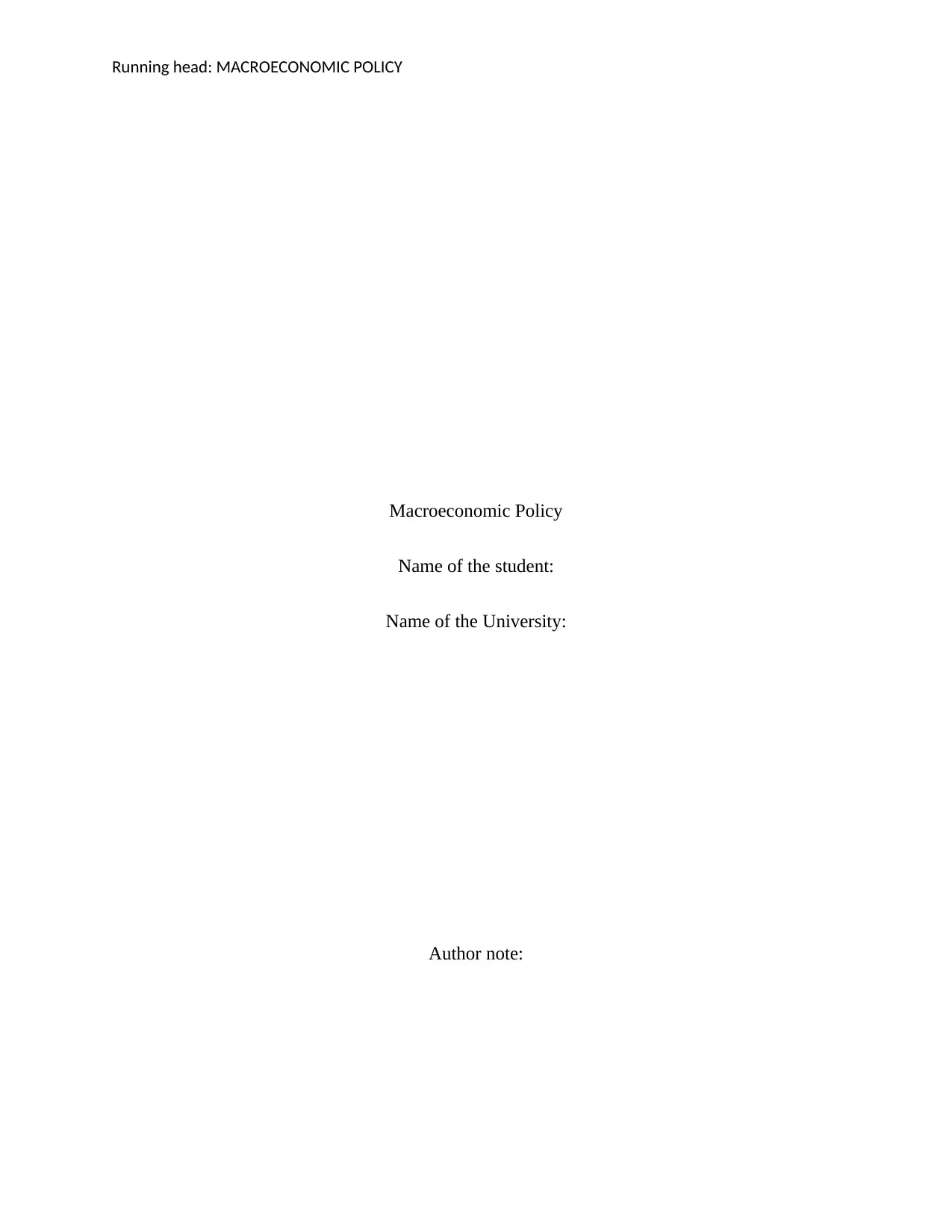
Running head: MACROECONOMIC POLICY
Macroeconomic Policy
Name of the student:
Name of the University:
Author note:
Macroeconomic Policy
Name of the student:
Name of the University:
Author note:
Paraphrase This Document
Need a fresh take? Get an instant paraphrase of this document with our AI Paraphraser
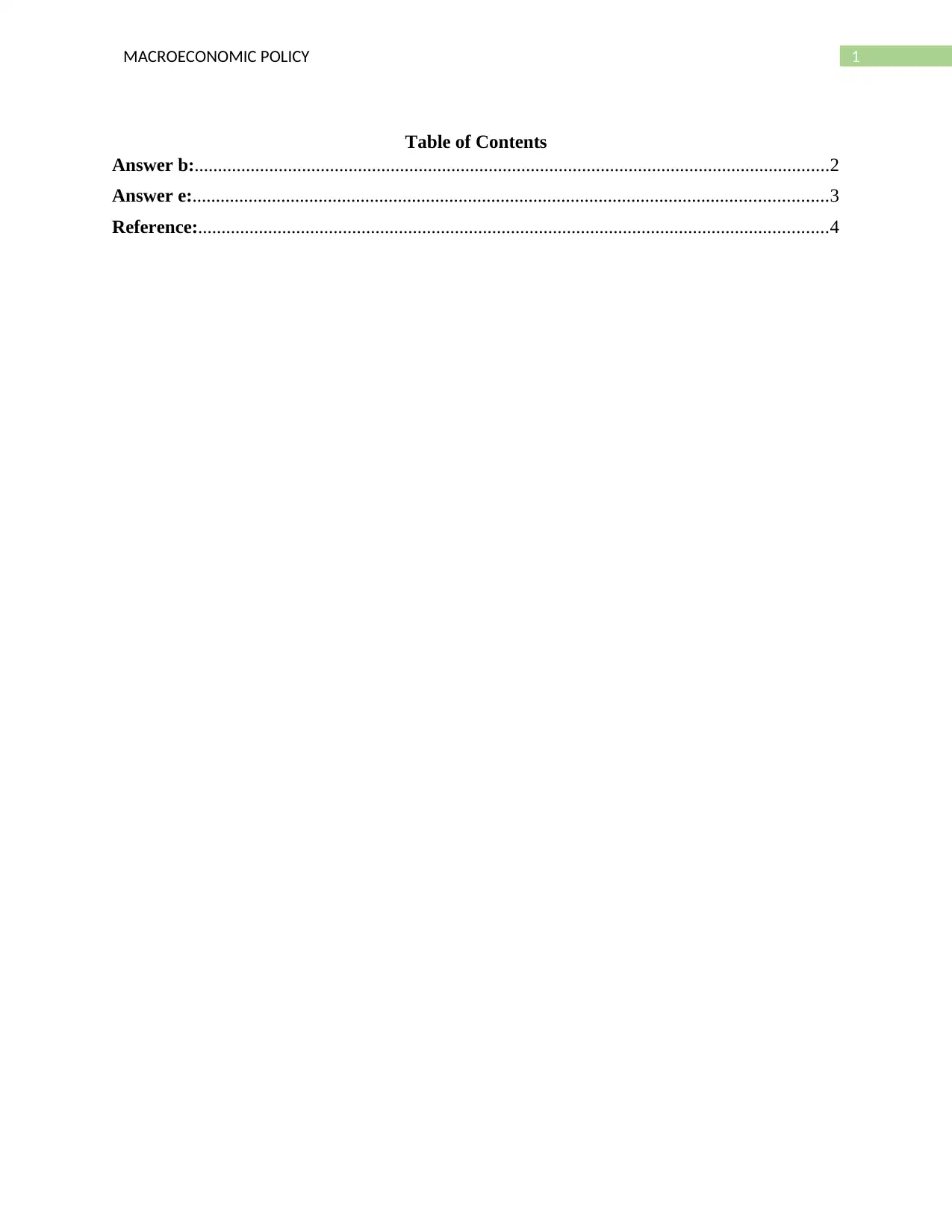
1MACROECONOMIC POLICY
Table of Contents
Answer b:........................................................................................................................................2
Answer e:........................................................................................................................................3
Reference:.......................................................................................................................................4
Table of Contents
Answer b:........................................................................................................................................2
Answer e:........................................................................................................................................3
Reference:.......................................................................................................................................4
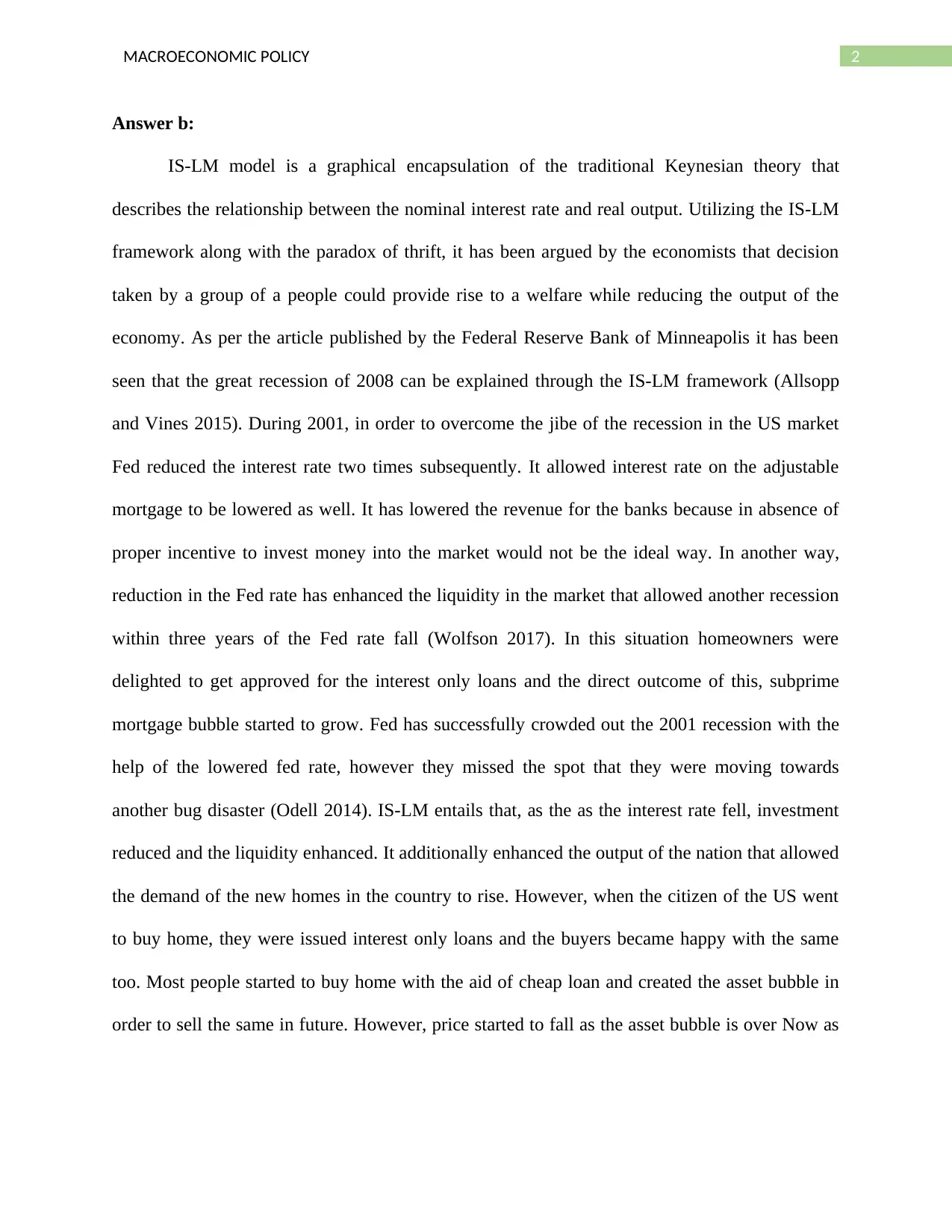
2MACROECONOMIC POLICY
Answer b:
IS-LM model is a graphical encapsulation of the traditional Keynesian theory that
describes the relationship between the nominal interest rate and real output. Utilizing the IS-LM
framework along with the paradox of thrift, it has been argued by the economists that decision
taken by a group of a people could provide rise to a welfare while reducing the output of the
economy. As per the article published by the Federal Reserve Bank of Minneapolis it has been
seen that the great recession of 2008 can be explained through the IS-LM framework (Allsopp
and Vines 2015). During 2001, in order to overcome the jibe of the recession in the US market
Fed reduced the interest rate two times subsequently. It allowed interest rate on the adjustable
mortgage to be lowered as well. It has lowered the revenue for the banks because in absence of
proper incentive to invest money into the market would not be the ideal way. In another way,
reduction in the Fed rate has enhanced the liquidity in the market that allowed another recession
within three years of the Fed rate fall (Wolfson 2017). In this situation homeowners were
delighted to get approved for the interest only loans and the direct outcome of this, subprime
mortgage bubble started to grow. Fed has successfully crowded out the 2001 recession with the
help of the lowered fed rate, however they missed the spot that they were moving towards
another bug disaster (Odell 2014). IS-LM entails that, as the as the interest rate fell, investment
reduced and the liquidity enhanced. It additionally enhanced the output of the nation that allowed
the demand of the new homes in the country to rise. However, when the citizen of the US went
to buy home, they were issued interest only loans and the buyers became happy with the same
too. Most people started to buy home with the aid of cheap loan and created the asset bubble in
order to sell the same in future. However, price started to fall as the asset bubble is over Now as
Answer b:
IS-LM model is a graphical encapsulation of the traditional Keynesian theory that
describes the relationship between the nominal interest rate and real output. Utilizing the IS-LM
framework along with the paradox of thrift, it has been argued by the economists that decision
taken by a group of a people could provide rise to a welfare while reducing the output of the
economy. As per the article published by the Federal Reserve Bank of Minneapolis it has been
seen that the great recession of 2008 can be explained through the IS-LM framework (Allsopp
and Vines 2015). During 2001, in order to overcome the jibe of the recession in the US market
Fed reduced the interest rate two times subsequently. It allowed interest rate on the adjustable
mortgage to be lowered as well. It has lowered the revenue for the banks because in absence of
proper incentive to invest money into the market would not be the ideal way. In another way,
reduction in the Fed rate has enhanced the liquidity in the market that allowed another recession
within three years of the Fed rate fall (Wolfson 2017). In this situation homeowners were
delighted to get approved for the interest only loans and the direct outcome of this, subprime
mortgage bubble started to grow. Fed has successfully crowded out the 2001 recession with the
help of the lowered fed rate, however they missed the spot that they were moving towards
another bug disaster (Odell 2014). IS-LM entails that, as the as the interest rate fell, investment
reduced and the liquidity enhanced. It additionally enhanced the output of the nation that allowed
the demand of the new homes in the country to rise. However, when the citizen of the US went
to buy home, they were issued interest only loans and the buyers became happy with the same
too. Most people started to buy home with the aid of cheap loan and created the asset bubble in
order to sell the same in future. However, price started to fall as the asset bubble is over Now as
⊘ This is a preview!⊘
Do you want full access?
Subscribe today to unlock all pages.

Trusted by 1+ million students worldwide
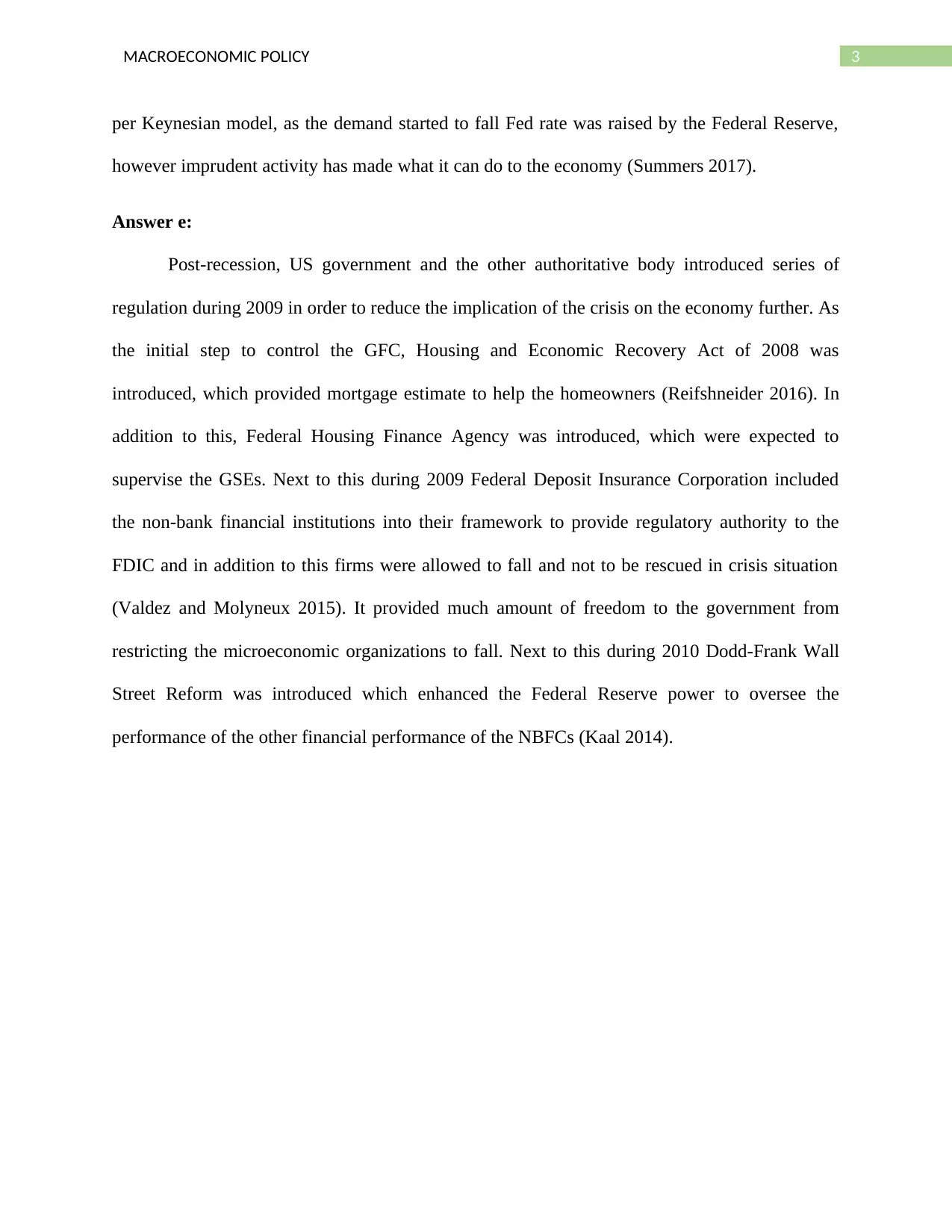
3MACROECONOMIC POLICY
per Keynesian model, as the demand started to fall Fed rate was raised by the Federal Reserve,
however imprudent activity has made what it can do to the economy (Summers 2017).
Answer e:
Post-recession, US government and the other authoritative body introduced series of
regulation during 2009 in order to reduce the implication of the crisis on the economy further. As
the initial step to control the GFC, Housing and Economic Recovery Act of 2008 was
introduced, which provided mortgage estimate to help the homeowners (Reifshneider 2016). In
addition to this, Federal Housing Finance Agency was introduced, which were expected to
supervise the GSEs. Next to this during 2009 Federal Deposit Insurance Corporation included
the non-bank financial institutions into their framework to provide regulatory authority to the
FDIC and in addition to this firms were allowed to fall and not to be rescued in crisis situation
(Valdez and Molyneux 2015). It provided much amount of freedom to the government from
restricting the microeconomic organizations to fall. Next to this during 2010 Dodd-Frank Wall
Street Reform was introduced which enhanced the Federal Reserve power to oversee the
performance of the other financial performance of the NBFCs (Kaal 2014).
per Keynesian model, as the demand started to fall Fed rate was raised by the Federal Reserve,
however imprudent activity has made what it can do to the economy (Summers 2017).
Answer e:
Post-recession, US government and the other authoritative body introduced series of
regulation during 2009 in order to reduce the implication of the crisis on the economy further. As
the initial step to control the GFC, Housing and Economic Recovery Act of 2008 was
introduced, which provided mortgage estimate to help the homeowners (Reifshneider 2016). In
addition to this, Federal Housing Finance Agency was introduced, which were expected to
supervise the GSEs. Next to this during 2009 Federal Deposit Insurance Corporation included
the non-bank financial institutions into their framework to provide regulatory authority to the
FDIC and in addition to this firms were allowed to fall and not to be rescued in crisis situation
(Valdez and Molyneux 2015). It provided much amount of freedom to the government from
restricting the microeconomic organizations to fall. Next to this during 2010 Dodd-Frank Wall
Street Reform was introduced which enhanced the Federal Reserve power to oversee the
performance of the other financial performance of the NBFCs (Kaal 2014).
Paraphrase This Document
Need a fresh take? Get an instant paraphrase of this document with our AI Paraphraser
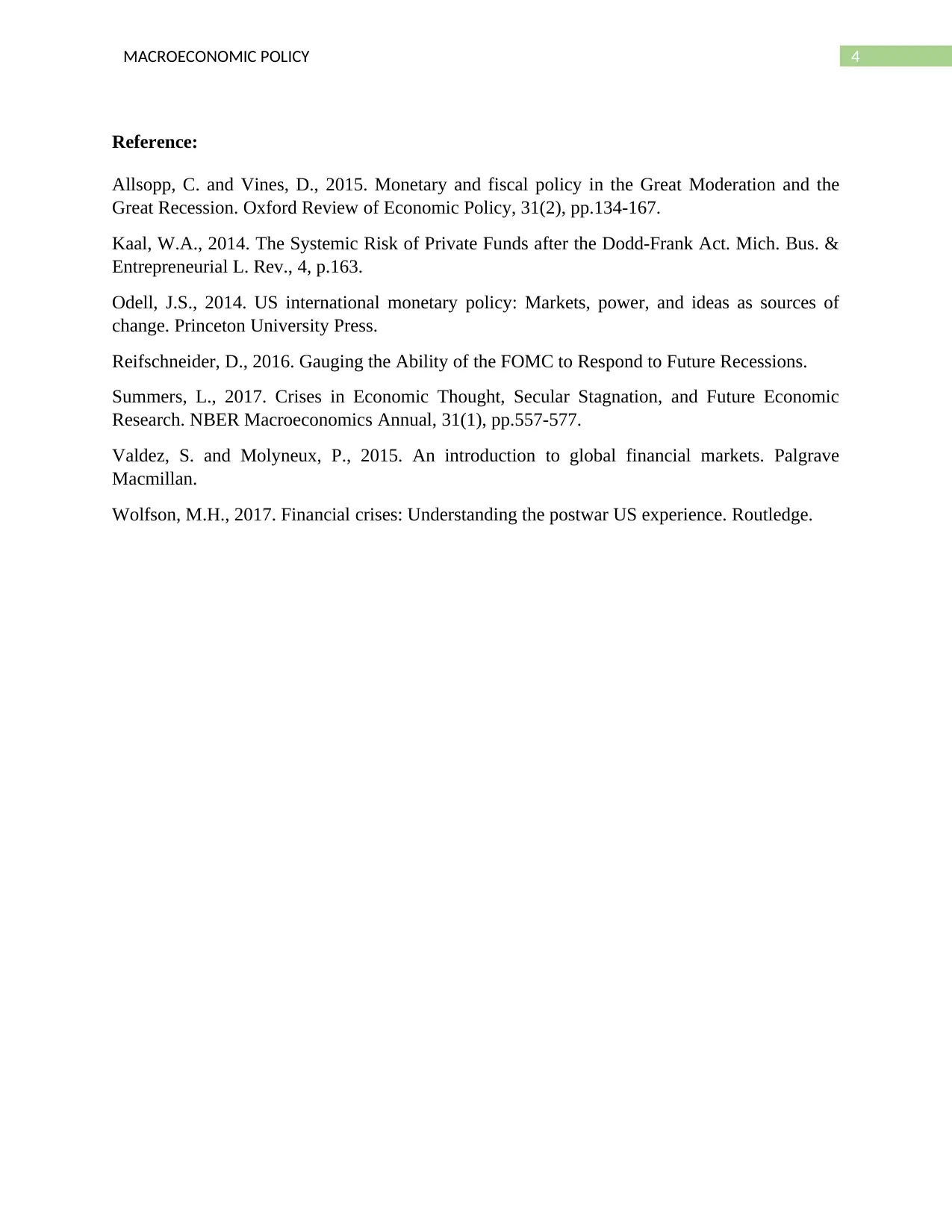
4MACROECONOMIC POLICY
Reference:
Allsopp, C. and Vines, D., 2015. Monetary and fiscal policy in the Great Moderation and the
Great Recession. Oxford Review of Economic Policy, 31(2), pp.134-167.
Kaal, W.A., 2014. The Systemic Risk of Private Funds after the Dodd-Frank Act. Mich. Bus. &
Entrepreneurial L. Rev., 4, p.163.
Odell, J.S., 2014. US international monetary policy: Markets, power, and ideas as sources of
change. Princeton University Press.
Reifschneider, D., 2016. Gauging the Ability of the FOMC to Respond to Future Recessions.
Summers, L., 2017. Crises in Economic Thought, Secular Stagnation, and Future Economic
Research. NBER Macroeconomics Annual, 31(1), pp.557-577.
Valdez, S. and Molyneux, P., 2015. An introduction to global financial markets. Palgrave
Macmillan.
Wolfson, M.H., 2017. Financial crises: Understanding the postwar US experience. Routledge.
Reference:
Allsopp, C. and Vines, D., 2015. Monetary and fiscal policy in the Great Moderation and the
Great Recession. Oxford Review of Economic Policy, 31(2), pp.134-167.
Kaal, W.A., 2014. The Systemic Risk of Private Funds after the Dodd-Frank Act. Mich. Bus. &
Entrepreneurial L. Rev., 4, p.163.
Odell, J.S., 2014. US international monetary policy: Markets, power, and ideas as sources of
change. Princeton University Press.
Reifschneider, D., 2016. Gauging the Ability of the FOMC to Respond to Future Recessions.
Summers, L., 2017. Crises in Economic Thought, Secular Stagnation, and Future Economic
Research. NBER Macroeconomics Annual, 31(1), pp.557-577.
Valdez, S. and Molyneux, P., 2015. An introduction to global financial markets. Palgrave
Macmillan.
Wolfson, M.H., 2017. Financial crises: Understanding the postwar US experience. Routledge.
1 out of 5
Related Documents
Your All-in-One AI-Powered Toolkit for Academic Success.
+13062052269
info@desklib.com
Available 24*7 on WhatsApp / Email
![[object Object]](/_next/static/media/star-bottom.7253800d.svg)
Unlock your academic potential
Copyright © 2020–2025 A2Z Services. All Rights Reserved. Developed and managed by ZUCOL.





